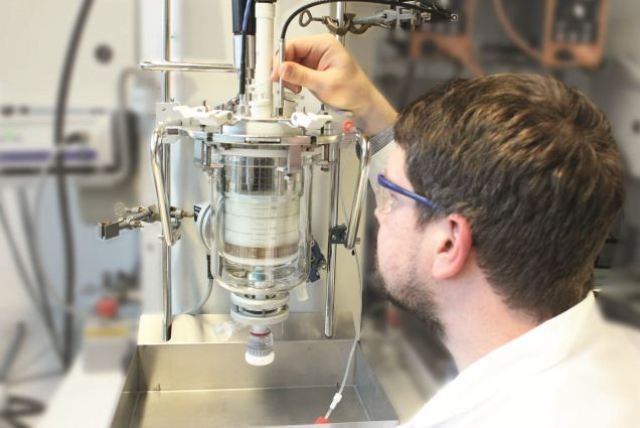Jun 2 2016
Today’s manufacturers face a great challenge in developing varnishes and wall paints, and one of the reasons could be that the samples of paints just allow them to assess the behavior of dispersion in the reaction container. Now, researchers from Fraunhofer are partnering with Potsdam-based PDW Analytics GmbH for the first time to continuously observe the production of varnishes, paints and adhesives in real time and thereby design a more effective method for developing paints.
 In the future a new sensor will make it possible to analyze the manufacturing process of wall paints and varnishes directly and in real time in the reaction container. © Photo Fraunhofer IAP
In the future a new sensor will make it possible to analyze the manufacturing process of wall paints and varnishes directly and in real time in the reaction container. © Photo Fraunhofer IAP
All wall paints are not the same and any person who has tried to paint a decorative wall with low-priced white paint can say this. Although very expensive and high-quality paints have exceptional coverage, the products bought with bargain discounts can enable the previously coated color paint to shine through. There is also a huge difference in drying properties, gloss finish and application. The material properties used in wall paint are mainly based on the size of the included particles, such as additives, pigments, filler material or bonding agents. Therefore, manufacturers feel that they have to know the process that takes place inside the reaction containers and how the particle sizes are changed. Usually, manufacturers analyze paint properties by taking a paint sample and thinning it down. This process is not only time-intensive, but it can change the properties of the wall paint as well as affect the sample. For example, when smaller particles clump together to produce larger particles, the size of the particle in the sample may differ from the size of the particle inside the reaction container.
Knowing what goes on in the reaction container at all times
This process will become more accurate, faster and simpler in the future as manufacturers will be able to evaluate wall paints, adhesives or varnishes in sequence. Therefore, all products can be directly analyzed in real time throughout the manufacturing process without the need for taking samples. A new sensor can make this process possible. The PDW Analytics staff has developed this sensor and the investigators from the Fraunhofer Institute for Applied Polymer Research IAP have incorporated that into their process development system.
This is a globally unique process-analytical detection method that allows key parameters in the manufacture of paints, varnishes and adhesives to be continuously monitored in real time. This helps us to get a much better understanding of processes, design them more efficiently and avoid production failures.”
Dr. Antje Lieske, head of department at Fraunhofer IAP
Hardware meets expertise
A sensor rooted in photon density wave spectroscopy, a method created by PDW Analytics, is at the center of this technology. It uses optical fibers to radiate laser light into the liquid wall paint and the force of this light is adjusted up to the range of gigahertz. Then, based on the frequency, the process analyzes how the light spreads in the liquid. Manufacturers can use this data to determine the size of particles. The IAP researchers have used the photon density wave spectroscopy method to create reference systems and measure different samples with the given particle sizes.
The Fraunhofer researchers are able to rebuild and evaluate manufacturing processes for their customers using the sensor.
We interface this novel sensor with our existing system as well as with our expertise.
Dr. Antje Lieske
Until now, the researchers have been using a process development station that allowed them to verify viscosity, heat flow and the particle sizes, especially in the case of suspensions with the size of particles between 1µm and 1mm. Additionally, an infrared sensor identified the chemical changes and revealed how the chemical reactions have improved. “With this new sensor, we can now also measure particle size across the entire relevant size range from nanometer to micrometer,” Lieske adds.
Customers can analyze their processes at the IAP, if a company is not able to resolve their issues. Since the entire system is portable, they can also use it at their facilities. Questions posed by the customers are: How polymerization time can be reduced? How to eliminate doubts in the processes and enhance material properties – for example, how to make sure that wall paints cover better or adhesives stick better?